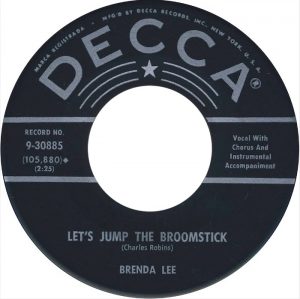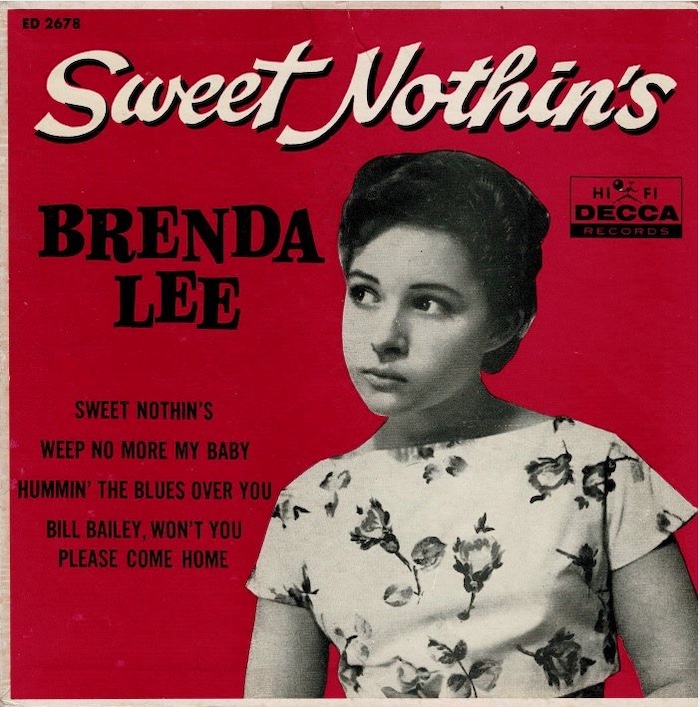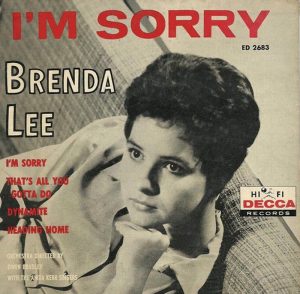Brenda Lee belied her age on feisty rockers like Bigelow 6-200, Rock The Pop, Dynamite, Little Jonah (Rock On Your Steel Guitar) and Let’s Jump The Broomstick. But her second album showed the young singer had more strings to her bow…
When the eponymously titled Brenda Lee entered the US album charts in the summer of 1960, the singer was not yet 16. But she was already an industry veteran, having been a professional singer since the age of six. This was her second LP, her singles had been on the Billboard Hot 100 since 1957, and she’d just tasted success on the British charts and become the first American to appear on Jack Good’s Oh Boy! She was the ultimate example of a rockin’ child prodigy.
Born in Atlanta, Georgia, in 1944, early appearances were under her birth name Brenda Mae Tarpley. By 1952 she was a regular on the local Atlanta television, but her big national break came in 1956 on the TV show Ozark Jubilee, which drew regular viewing figures in excess of 20 million. A contract with Decca had followed and then came the hits, small at first but gathering momentum with Sweet Nothin’s in 1959, and then the chart-topping smash I’m Sorry in the spring of 1960. Naturally, both featured on Brenda Lee.
Great All-Rounder
Lee was an immensely driven starlet. Straitened family circumstances were made worse by the death of her father when she was eight, meaning the money she made from her concert, radio and TV appearances provided vital income for her struggling mother.
It’s possible that this tough upbringing added a layer of gritty authenticity to Lee’s feisty rasp, allied to an attested love of listening to R&B singers like Fats Domino and Ray Charles, and the gospel great Mahalia Jackson. Lee sang with an unforced melisma that was highly soulful and not only ahead of her time for a white artist, but astonishing in one so young.
But she was also a great all-rounder with a good range. Rockabilly, rock’n’roll, R&B, country, pop and the standards were all delivered with ease. Brenda Lee was an album sung by a teenager, but it contained hints of the mature crossover artist that she would become.
Respect The Success
Perhaps, because of her professionalism, Lee hasn’t always got the respect that she deserves. Yet among the select list of female singers who did rockabilly, including Wanda Jackson, Janis Martin, Rose Maddox, Jean Chapel, Barbara Pittman and a young Jackie Dee (the future Jackie DeShannon), Lee sold the most records. Many mistook Wanda Jackson’s Let’s Have A Party for a Lee song, such was the similarity of their throaty approach to rock’n’roll. Jackson, like Lee, was also at heart a great country singer, but it was Lee, combining a bluesy, soulful feel with the vocal technique of an accomplished pop artist, who became one of the biggest selling crossover stars of the 1960s. Lifetime record sales have been calculated to be in excess of 100 million, and her role in the popularisation of the Nashville Sound has also been underplayed.
Lee was one of the first singers of either sex to achieve fame via television. The impact of that big voice coming from such a tiny, young person when she first broke nationally was expressed years later by the now somewhat forgotten Ozark Jubilee host Red Foley, a household country singing star and entertainer in the 1950s.
Quoted in Little Miss Dynamite, written by Lee with Robert K. Oermann and Julie Clay, Foley recalled that: “I still get cold chills every time I think about the first time I heard that voice. Midway through the show we put her on, and she reared back and let go. One foot started patting out the rhythm like she was putting out a prairie fire, and not another fibre of her little body moved. And when she did that trick of breaking her voice, it jarred me enough to realise I’d forgotten to get off the stage after introducing her.”
Natural Rockabilly
Lee’s first Decca recording session took place in Nashville in July 1956. Just months before, Elvis had stormed the national charts with Heartbreak Hotel. Lee had seen him when he performed in Georgia and been taken backstage to meet him. That first Nashville session showed how naturally she’d imbibed the rockabilly style, two of the tracks emerging as a single in the form of a hopped-up version of Hank Williams’ Jambalaya (On The Bayou) and the pure rockabilly of Bigelow 6-200.
Yet to dismiss her as a Presley imitator would be wrong. “I was just doing what came naturally. The hiccupping little vocal trick I did was just there,” Lee recalled in Little Miss Dynamite. “No one ever told me to do that. I didn’t know it was part of the rockabilly style, because no one called it that back then.”
While the hiccupping Bigelow 6-200 was absent from Brenda Lee, Jambalaya was there, albeit in a later version, given a poppier setting with the chirpy sax of Boots Randolph and backing vocals from The Anita Kerr Singers. Also included was Dynamite, a bouncy rocker which had scraped into the bottom of the charts in 1957. Again, the album featured a later recording of the song. Although some might lament the fuller Nashville backings on the album versions, particularly on Dynamite, there’s no doubt that the growing maturity in Lee’s voice represents an improvement.
For all the Nashville sessions which yielded the material for Brenda Lee, the experienced Owen Bradley was the producer. Backing was provided by the likes of Grady Martin, Hank Garland, Harold Bradley, Buddy Emmons, Floyd Cramer, Buddy Harman and Bob Moore, names familiar across countless Music City sessions over the years.
Sweet Nothin’s
Often criticised for their conservatism, these Nashville musicians seemed energised by this teenage pocket rocket. “We loved her from Day One,” Harold Bradley recalled for her autobiography. “It was like being on a football team. Brenda was running for a touchdown and we were blocking like crazy – everybody was strumming like crazy.”
Let’s Jump The Broomstick was typical of the playful tone of Lee’s early Decca recordings. The title referenced an old American euphemism for getting married. Not a hit in the States when released in 1959, it made No.12 when released on Brunswick in the UK in 1961 and was to remain one of Lee’s most popular songs.
Sweet Nothin’s emerged from a session in the summer of 1959 and signified progress towards a more adult style. Written by Ronnie Self, it was destined to be her first Top 10 hit in the US. It starts with Lee engaged in a phone conversation with a whispering lover, the barely audible male voice supplied by Louis Nunley of The Anita Kerr Singers. Some deejays at the time thought the lyric slightly risqué for one of Lee’s age (“Mama turned off the front porch light sayin’/ ‘Come in darlin’ that’s enough for tonight,’”) but to her delight it got plenty of airplay on R&B radio stations and reached No.4 on the Billboard Hot 100.
Swinging Treatment
(If I’m Dreaming) Just Let Me Dream sounds like a would-be follow-up and Heading Home also had impeccable R&B credentials. It had been written by The Platters’ manager Buck Ram and recorded by Shirley Gunter and The Flairs in 1956, before getting a more swinging treatment by the idiosyncratic Della Reese not long after.
The teenaged Lee’s version naturally doesn’t have the same authority as these earlier recordings, but it was striking enough. Weep No More My Baby, written by Marijohn Wilkin and John D. Loudermilk, was later given a fine workout by Johnny Kidd And The Pirates.
However, the most significant song on the LP was another one from the pen of Ronnie Self, the heartbreak ballad I’m Sorry.
Little Miss Dynamite’s Big Breakthrough
Owen Bradley had recognised for some time that Lee had the potential to expand her repertoire, but he was not initially impressed, believing the song to be repetitious. However, Lee, who loved The Ink Spots’ spoken recitations in their songs, came up with the suggestion for a spoken verse. She claimed the emotional “oh-oh-oh” she added was just a slowed down version of the hiccupping she deployed on her rockers. Floyd Cramer played the piano and, with the addition of strings, this was destined to be one of the great Nashville crossover hits.
Yet Decca’s bosses were reluctant to release the recording, believing the sentiments expressed were too dark for their young interpreter. So I’m Sorry went out on the B-side of That’s All You Gotta Do, a breezy, uplifting number that pushed Lee’s throaty rasp and country twang right up front. It had been written specifically for Lee by future country star Jerry Reed. However, DJs decided they preferred I’m Sorry and it soon became Lee’s pop ballad breakthrough.
Capable of mixing country and pop balladry with rockers, Brenda Lee is a unique talent. But her eponymous second LP, released when she was poised on the doorstep of the most commercially successful phase of her long career, caught her at her most refreshing and new.
For more on Brenda Lee click here
Read More: Story Behind The Song – Brenda Lee’s Rockin’ Around The Christmas Tree









